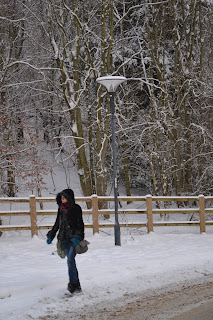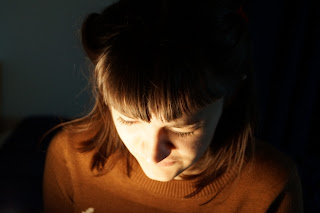Evidently, I thought, this tendency had increased till
Industry had gradually lost its birthright in the sky.
I mean that it had gone deeper and deeper into larger and ever
larger underground factories, spending a still-increasing
amount of its time therein, till, in the end - !
H.G. Wells "The Time Machine"
Mise en scene.
Location 1.
The setting is undeground city where workers are living. There is a clock in it, which has got only 10 numbers, not 12.
Workers are a big crowd, they are moving like a big machine, very synchronically and resignedly as robots. There are a few groups of them and they are working in rotation. Also they've got the same black cloths and caps, so they look more like prisoners than free people. It's tells us that they are similar to each other and don't have their own opinion, they are weak. The scene is made in dark way with some blue colours, the low key lighting makes it depressed and a bit scary, transforming the crowd into a big shapeless thing. The words and letters in the subtitles are moving from below to above like the workers, when they are going up a lift. Everything shows that we see a factory, especially the beginning of the film with moving machines. Furthermore it looks like the place where they are living not very big, for example when they are going and when they are staying in the lift we can see that they locate very close to each other, which signifies they haven't got any space to move separately.

As stated above they are living undeground like moles, only working every day on the elite. It's very symbolic, because they don't see sunlight and peace, but only dirt and darkness. I presume, the elite believes that they are not people but robots, who not even dare to be tired.
Location 2.
Above that dark place there is another world - the elite. They don't work, but having fun under the sun. They are very similar to children - they don't think about problems, because they don't have them, furthermore they are happy and wealthy, individual and can do what they want. They are free in everything, for instance in sport (they are running which signifies freedom too), in love (the scene in a pleasure garden) and in choosing (they've got different cloths and moving in different ways).
Because of the lighting the garden is looks gold and adorable, it full of peace, but it's quite illusory too - like in a dream - and it seem like these people will wake up. Also there is a huge wall which signifies that the elite doesn't want to go outside, it's in a safe place, but this wall does not only protect them, it also separates them from everything. Maybe somebody will want to look what is outside? Qui sait.
These two locations are very different, because we see two different types of people - rich and poor. One side is rich, another is enslaved. The way they are living reminds me the caste system in India. But there are only two positions: the most powerful one and the untouchable one.
The lighting is different - in first location it's low key to show the mysterious mass, but in the second location there is high key lighting to make the people and the environment like from a fairytale. Also we cannot see workers' faces, which signifies not only the fact that they haven't got anything, but that we cannot see what is inside their souls, about what they are thinking, whereas the elite has light faces and eyes and it's ease to understand what they want to do.
But the elite cannot live without the workers. Wealthy people are very powerful but they don't work, everything is done by the workers. It's a very dangerous situation for the wealthy people.
The main protagonists.

The main protagonist are always in the foreground and in the centre, they are individual and bright. For example we see a girl on the photo above. She is in the centre of the picture, high key lighting picks out her body, she is taller than children and she is the first person we see on the photo. Also she and her future beloved are the first people in the Metropolis which names we heard, or, what will be more proper, read. They've got white cloths, but her dress is simple and poor whereas his cloth is more expensive. She is living underground, but he is one of the elite group. They are like Romeo and Juliet - fall in love at first sight. We understand this when they are looking at each other silently and for a long time. Moreover he is touching his chest like he is holding his heart and this also signifies love. He is a young man, handsome (remember the time of making the film - 1926) and rich, she is looks like an angel (because of the light above her hair) - it's not surprising that they fall in love - it's one of the major film's features.




































